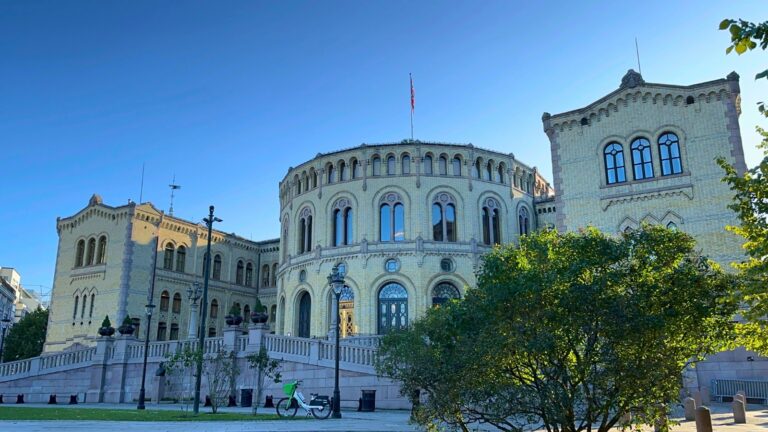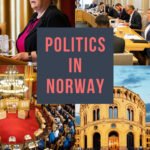Ahead of Norway's critical election, learn about the political parties in Norway with this introduction to the parties represented in the Norwegian parliament.
With the 2025 general election just days away, Norway’s political landscape is in flux. Opinion polls are swinging wildly, and no one is certain who will form the next government.

Labour’s Jonas Gahr Støre is fighting to stay on as prime minister, but the right-wing Progress Party is polling strongly, while Erna Solberg’s Conservatives are hoping for a comeback. As always in Norway, coalition building will be essential.
The centre-left bloc remains slightly ahead overall, but Labour’s path to a stable government may require support from both SV and Rødt, which is a tough ask. Meanwhile, Progress (FrP) is challenging the Conservatives (Høyre) for dominance on the right.
How Parliamentary Elections Work in Norway
The Norwegian parliament (Stortinget) has 169 members, each elected for a four-year term. Unlike in the UK, there is no option to call a snap election: terms always run their course.
While long-term residents of Norway can vote in local elections, only Norwegian citizens can vote in parliamentary elections. As such, this marks the first parliamentary election I can vote in since becoming a Norwegian citizen.
Norway uses proportional representation in multi-seat constituencies, with seats distributed by the modified Sainte-Laguë method. This ensures that the share of seats is broadly proportional to the share of votes, with some important adjustments:
Levelling seats (4% threshold): To prevent small parties being shut out, additional seats are allocated to parties that cross the 4% national vote threshold. Falling short of this line has dramatic consequences. For example, in 2017 the Greens (3.24%) received just one seat, while the Christian Democrats (4.2%) earned eight.
Rural weighting: Rural constituencies are slightly overrepresented to balance Norway’s geography and prevent urban centres from dominating parliament.
Coalition governments are the norm in Norway, often involving three or more parties.
The 2017 Election
- Labour (Ap): 27.4% – 49 seats
- Conservatives (H): 25.0% – 45 seats
- Progress (FrP): 15.2% – 27 seats
- Centre (Sp): 10.3% – 19 seats
- Socialist Left (SV): 6.0% – 11 seats
- Christian Democrats (KrF): 4.2% – 8 seats
- Liberals (V): 4.4% – 8 seats
- Red (Rødt): 2.4% – 1 seat
- Greens (MDG): 3.2% – 1 seat
Erna Solberg’s Conservatives continued in government, leading a centre-right coalition.
The 2021 Election
- Labour (Ap): 26.3% – 48 seats
- Conservatives (H): 20.4% – 36 seats
- Centre (Sp): 13.5% – 28 seats
- Progress (FrP): 11.6% – 21 seats
- Socialist Left (SV): 7.6% – 13 seats
- Red (Rødt): 4.7% – 8 seats
- Liberals (V): 4.5% – 8 seats
- Christian Democrats (KrF): 3.8% – 3 seats
- Greens (MDG): 3.9% – 3 seats
- Patient Focus: 1 seat (regional list in Finnmark)
The result gave a majority to the centre-left. Jonas Gahr Støre (Labour) became prime minister, leading a minority Labour–Centre–SV government.
Arbeiderpartiet (Ap)
Labour Party. Norway’s traditional powerhouse of politics, the Labour Party is social democratic, focused on welfare, public services, and moderate climate policy.
Former Ap leader and prime minister Jens Stoltenberg made a surprise return to frontline politics in 2025 following a ten-year stint at NATO.
In their words: “The Norwegian Labour Party is a social democratic party committed to liberty, democracy and social justice.It is a reformist party that believes in partnership and cooperation on national as well as international level. By acting together rather than just as individuals, we can make a better society for all.”
Founded: 1887
Leader: Jonas Gahr Støre
Høyre (H)
Conservatives. The party led by former Norwegian prime minister, Erna Solberg, who is hoping to return to the top job.
In their words: “The Conservative Party will pursue a conservative progressive policy based on Christian cultural values, constitutional government and democracy to promote personal freedom and social responsibility, co-determination and ownership rights, and a binding commitment to national and international cooperation.”
Founded: 1884
Leader: Erna Solberg
Fremskrittspartiet (FrP)
Progress Party. FrP is Norway's farthest right mainstream party, having gathered momentum throughout the 2000s and early 2010s. In 2013 the populist party entered government for the first time as part of Erna Solberg's (H) first coalition.
In their words: “The Progress Party is a libertarian party that believes in freedom for the individual, lower taxes, prosperity and a limited government that empowers people.”
Founded: 1973
Leader: Sylvi Listhaug
Senterpartiet (Sp)
Centre Party. Despite the name, Norway's Centre Party is hard to define by modern political terms. Over their life they have joined both left- and right-leading coalitions.
They have their roots as a farmers' party, and campaign primarily on issues of protectionism and decentralisation. Often a coalition kingmaker.
In their words: “Good services close to people provides security and predictability in everyday life. The Centre Party believes that proximity is the answer – not the problem. We live in an elongated country where proximity has played an important role. It has created vibrant local communities in the north, south, east and west and has been a success story for our country.”
Founded: 1920
Leader: Trygve Slagsvold Vedum
Sosialistisk Venstreparti (SV)
Socialist Left. Formed out of a coalition of smaller socialist parties and independents, SV is a mainstream democratic socialist party that pitches itself to the left of Labour. Campaigns typically revolve around a strong public sector, stronger social welfare programs and increasingly, environmentalism.
SV were part of Norway's coalition government from 2005 to 2013, led by Jens Stoltenberg.
In their words: “The differences between the financially privileged and most ordinary people are increasing. While those who are impoverished or sick are being hit by welfare cuts and the help available is being eroded, right-wing politicians are constantly cutting the taxes paid by the elite. If these unfair differences are allowed to continue the society of tomorrow will be a colder place.”
Founded: 1975
Leader: Kirsti Bergstø
Venstre (V)
Liberal. Despite the name translating as ‘left', Norway's Venstre takes a centrist stance. Left refers to the social-liberal stance of personal freedoms under an active state.
The party takes a pro-immigration stance and is one of the more vocal supporters of European cooperation. However, the party stops short of advocating EU membership. Venstre have previously supported Erna Solberg's governments as either full members or on a confidence-and-supply basis.
In their words: “Liberal policy is made with the individual at heart. We crave fair solutions that would bring freedom to everyone. We believe that everyone should have the opportunity to use their abilities to the best for themselves and the society.”
Founded: 1884
Leader: Guri Melby
Kristelig Folkeparti (KrF)
Christian Democrats. KrF combines a socially conservative stance with centre-left economics. Christian values remains its core distinction. Former leader Kjell Magne Bondevik served as Prime Minister from 1997 to 2000 and from 2001 to 2005. As with Venstre, KrF have supported (formally and informally) previous Solberg governments.
In their words: “The Christian Democrats (KrF) has a vision of building an open society based on Christian and humanistic values in which responsible and value oriented citizens serve each other.”
Founded: 1933
Leader: Dag Inge Ulstein
Miljøpartiet De Grønne (MDG)
Green Party. While MDG distance themselves from the traditional left and right blocks in Norwegian politics, the party's policies place them firmly on the left. They advocate green policies and social progressivism.
In their words: “The Greens want to create a society where we have good lives without destroying others. Norway stands at a crossroads, where long-term security, freedom and welfare for all are at stake. We have to deal with the goal of constantly producing more to buy and throwing more away. The Greens say no to the exploitation of people and the environment current politics.”
Founded: 1988
Leader: Arild Hermstad
Rødt (R)
Red. Norway's farthest left party with a representation in parliament, Red believes in the creation of a classless society, replacing capitalism with socialism. They entered parliament for the first time in 2017, winning a single seat.
In their words: “A society based on equality is healthier, happier, and more socially just than a society based on capitalist competition. Community works. Cooperation works. Solidarity works. That’s why the fight against the increasing gap between the wealthy and those who struggle to make ends meet is Rødt’s priority.”
Founded: 2007
Leader: Marie Sneve Martinussen
Pasientfokus – Patient Focus
A single-issue regional party from Finnmark advocating for better local healthcare.
Founded: 2021
Leader: Irene Ojala
Other Political Parties in Norway
Norway has dozens of smaller parties that rarely cross the 4% threshold. Some run only in local elections, while others push single-issue agendas. Notably, a new party, Peace and Justice (Fred og Rettferdighet, FOR), is running in 2025 on an anti-NATO and pacifist platform.
Separate from the national parliament, the Sami Parliament in Karasjok has 39 representatives, elected every four years across seven constituencies. It represents Norway’s Indigenous Sami population on cultural and political issues.



You have a democracy their roots are deep.This meaning Also better represantation and govermant.l have learned very much useful information about Norway s democracy and parliament system.l have been İn Norway İn 1995 that time Also your country has a good sample of representation. Bruttlant.İ remembar this Ladies as a primer minister of Norway. A bright future for Norway always l wish.Greetings from Türkiye.
The person you refer to is Brundtland.
All of these parties are largely like political culture-heritage camps. The actual policy disagreements in Norwegian politics are very minor. Every party is pro-NATO and anti-Russia now – a few are pro-EU but nobody serious suggests joining anymore, so basically all parties would maintain membership in EFTA without the European Union. Progress Party complains about immigration but doesn’t seriously suggest a massive reduction. Bureaucratic requirements for, and restrictions on, immigration are always increasing but the numbers keep increasing. No party serious suggests mass nationalisation of industries or privatising the health service or Statoil. Even the Christian Democrats have largely abandoned opposition to abortion and gay marriage.
These are just flavours driven by the cultural heritage or class status of different sectors of Norwegian society – it does not represent serious ideological diversity.